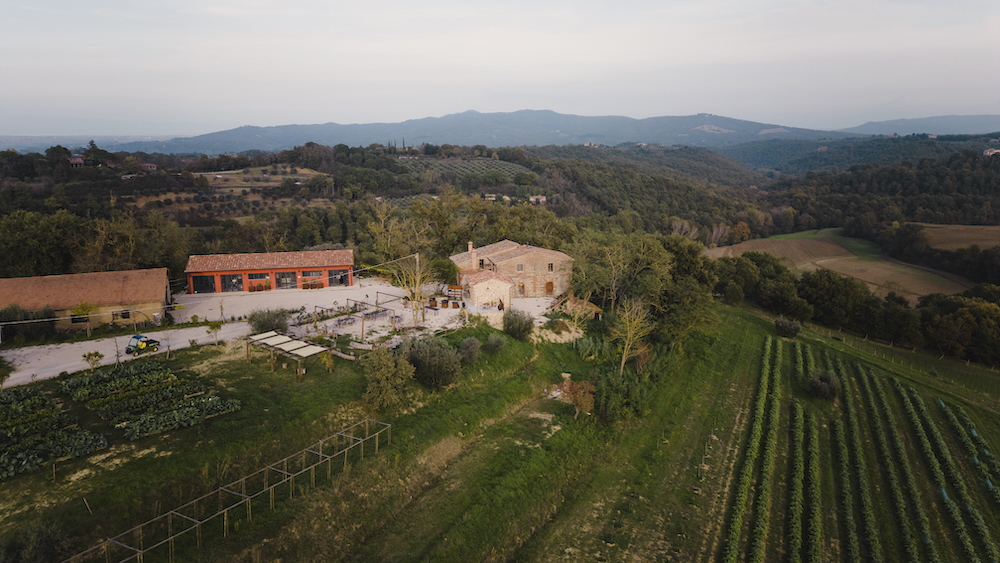Two ambitious brothers are building an innovative, future-proof farm in the heart of Italy. By learning from nature and adopting the latest cutting-edge technology, they are creating a farm model that is resilient to changing climate conditions. Could Quintosapore provide a viable agricultural model for the future? Food Inspiration paid the farm a visit – and was impressed with the results gained in just 5 years. We spoke with Nicola Giuggioli about their innovative approach. “We like to think of ourselves as more than just farmers. We are biodiversity activists.”
It promised to be a scorching hot day, when my class of the EIIS Food & Sustainability program boarded our bus, for the three-hour journey from Rome to Città della Pieve in Umbria for a farm visit to Quintosapore. Upon arrival, we were welcomed by Nicola Giuggioli and his team. From the very first moment, their passion was tangible. Step by step, we toured the farm – the main buildings, the crop beds, the greenhouse, the outdoor kitchen area, the vineyard, and the small shop. We conclude with a delicious lunch, prepared with all the delicious produce harvested from the land that morning. The fact that we were slowly melting in the 40-degree heat only makes their story all the more impactful.
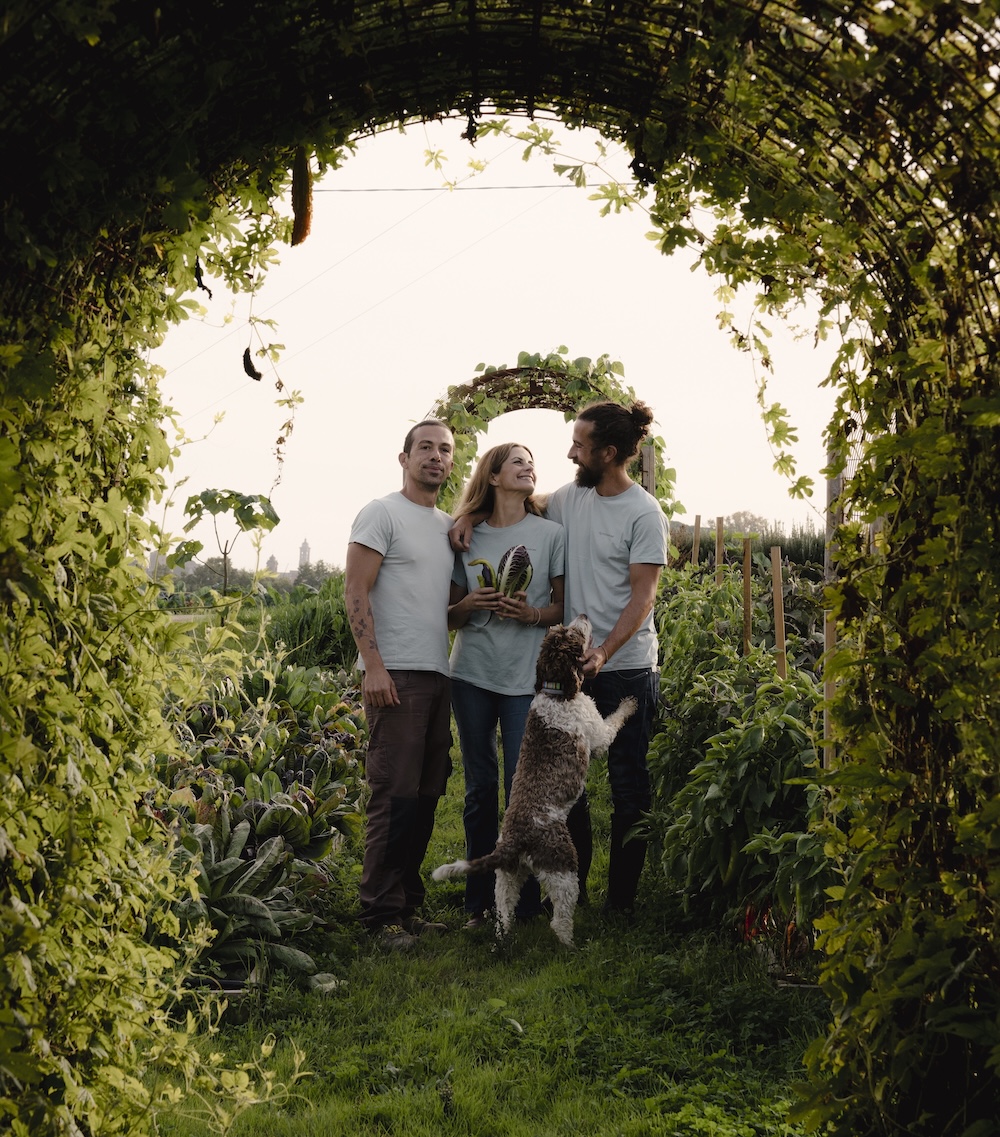
“My twin brother Alessandro and I always shared a dream of farming together”, Nicola says. “It all started in our small home garden, where as little boys we began germinating our first seeds.” Life then led the two into completely different careers, moving away from their birthground for several years. Now, the passion for ancient and forgotten crops that has driven them since childhood, has become their fulltime job.
When founding Quintosapore in 2020, the siblings chose a multidisciplinary, holistic approach to farming. Their primary goal is to grow nutritious food in a way that benefits both people and the planet. “Healthy soil produces nutrient-rich food that is full of minerals and vitamins and helps people thrive. We want our farm to be a center for research and development for new agricultural technologies, with a focus on sustainability, nutritional value, and climate resilience. Our philosophy is simple: we combine ancient natural wisdom with cutting-edge innovation to create a holistic approach to agriculture. Today, with over a thousand species under cultivation, we are one of the most biodiverse farms in the world. Quintosapore aspires to become a global beacon for sustainable agriculture, and becoming a blueprint for farms everywhere.”
"We like to think of ourselves as more than just farmers. We are biodiversity activists.”
Manifesto: Quintosapore’s 10 guiding principles
-
Self-production of seeds
-
Research and cultivation of heritage varieties
-
Exclusively seasonal products
-
Production based on natural principles
-
Produce healthy and nutritious food
-
Total exclusion of pesticides and outsourced fertilizers
-
Harvesting only ‘by hand’
-
Circular economy model
-
Multidisciplinary approach
-
Social inclusion and respect for workers
"The brothers aim to build a farm model that can withstand economic shocks, market shifts, and environmental disruptions"
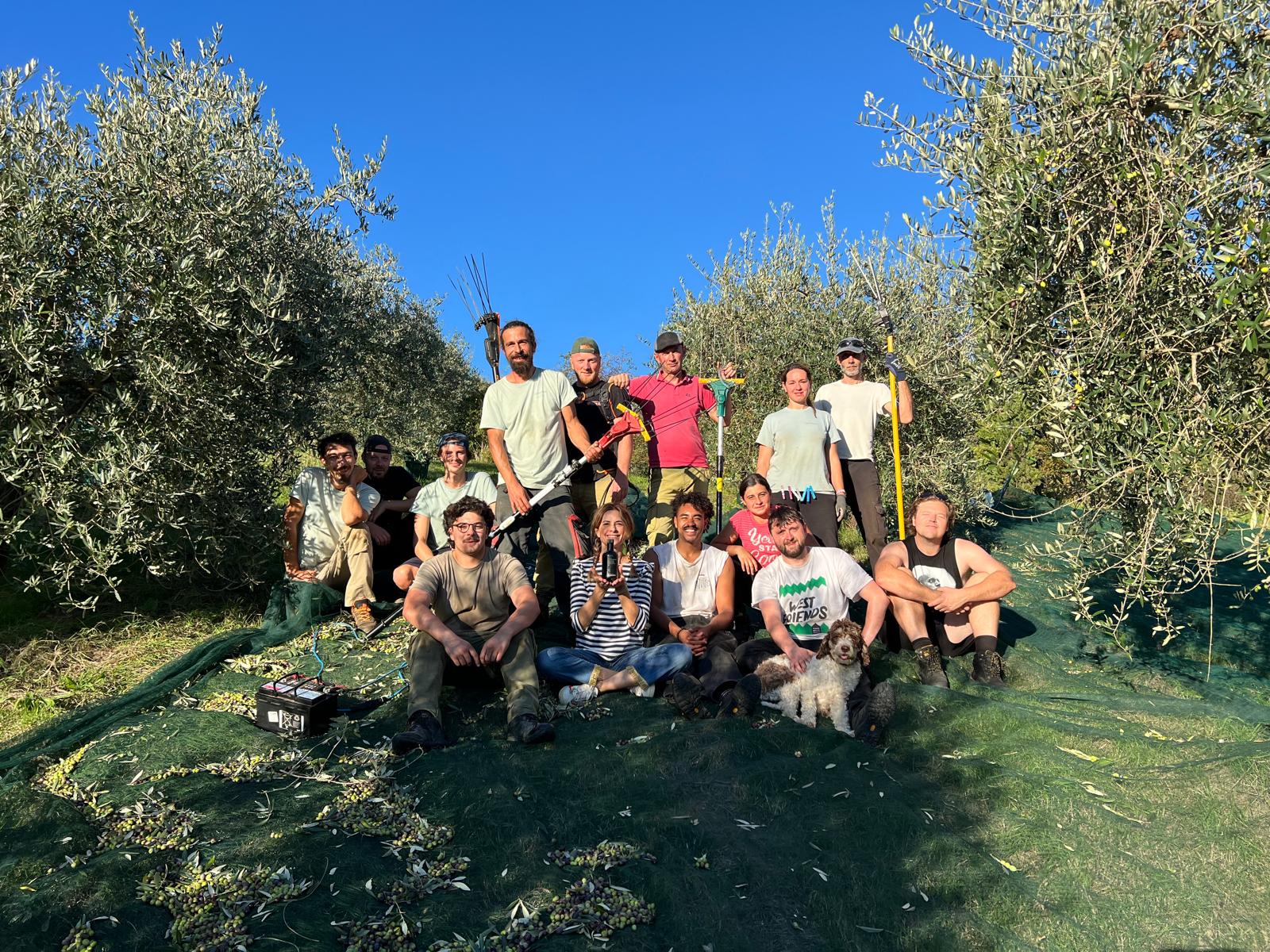
Financial resilience: a business model on 4 pillars
“We envision a future where farming sustains not only the land, but also the financial health of farmers and their communities.” Through diversification, innovation, and strategic planning, the brothers aim to build a farm model that can withstand economic shocks, market shifts, and environmental disruptions. By prioritizing sustainable profitability, fair access to resources, and long-term viability, they are working toward a thriving agricultural sector.
Currently, Quintosapore has a diversified business model, with revenues in four different areas of activity, that now all account for approximately 25% of the business.
-
Shop: selling fresh seasonal produce in the local store in town.
-
Delivery: delivering fresh produce to consumers and local businesses nationwide.
-
Events: soil-to-fork experiences, farm tours, weddings and private parties.
-
Export/webshop: seed-to-jar product line.
Since they started this business model in 2023 every part of the business has doubled turnover year on year. “We are looking to break even by the end of 2025. And we aim to make our shelf-stable seed-to-jar product line the main part of the business within two years.”
-0463.jpg)
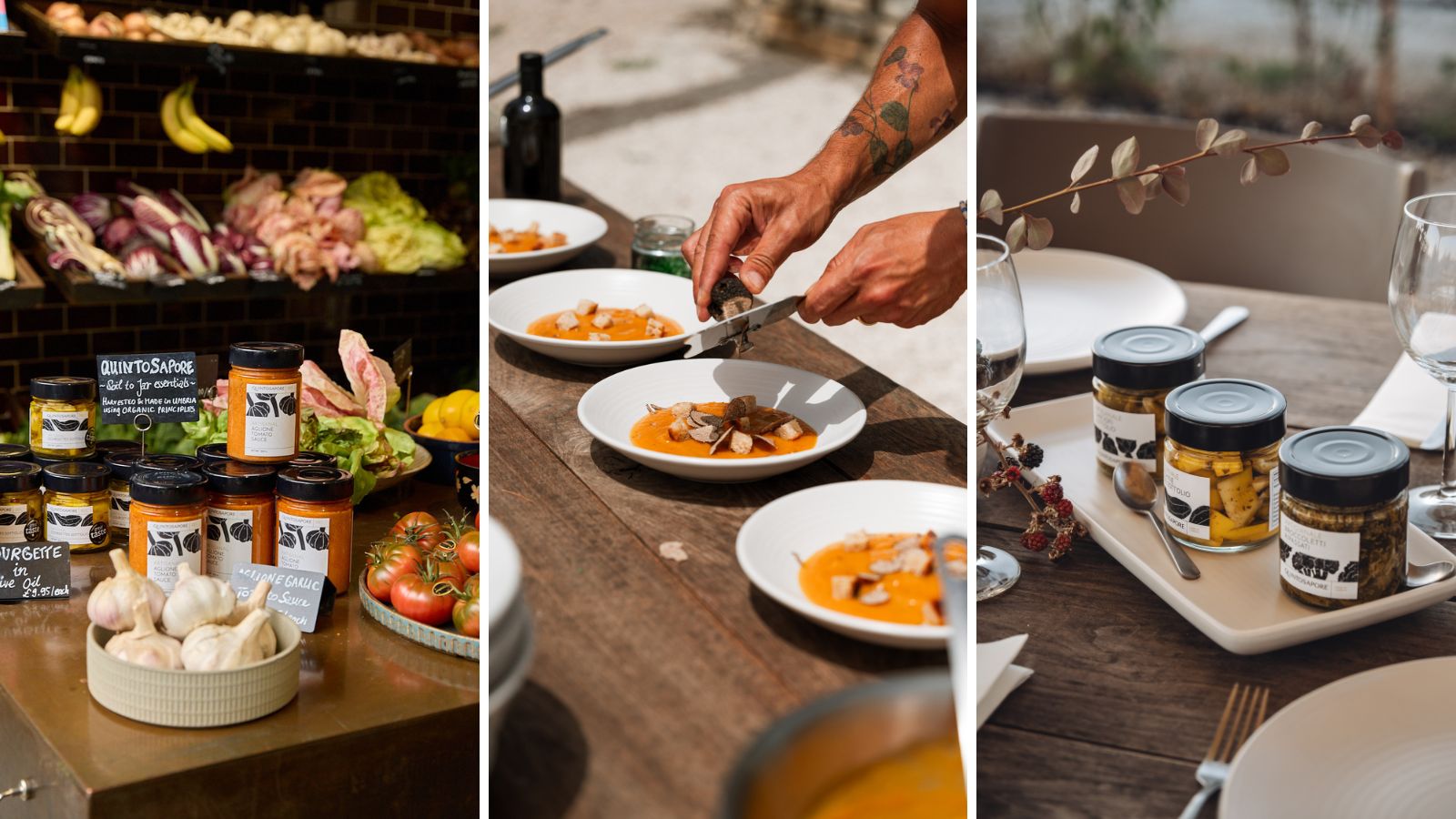
The world’s first biomimic farm
Biomimic farming – also known as biomimicry in agriculture – is about emulating and incorporating natural systems and processes into farming environments. It draws direct inspiration from the efficient, sustainable ways in which nature produces food. This includes replicating the dynamics of ecosystems, such as nutrient cycling, soil regeneration, and natural pest control.
By mirroring nature’s patterns, farmers can create diverse, resilient, and balanced environments. This reduces reliance on synthetic inputs and encourages organic, regenerative farming methods. Biomimic farming aims to improve yields while preserving healthy soils and thriving ecosystems. “Our main focus is to listen to and understand the soil – and the life it supports – from seed to harvest.”
"Seed sovereignty became central to our model, it boosts resilience to climate change"
How self-producing seeds became key to resilience
“We started out with regenerative and organic methods and aimed to get certified organic. But in Italy, certification is granted per product – not per farm. And only around 30 varieties can be certified, while we started with over 500 crops. We partnered with Slow Food to find a solution. The certifying body agreed to certify us, providing we self-propagated all our seeds and seedlings. It turned out to be a blessing. Most of the varieties we grow are rare or unique – so we couldn’t buy them even if we wanted to.
In a way, seed sovereignty became central to our model. It boosts resilience and adaptation to climate change. Commercial seeds are optimized to grow in different soils and microclimates. If you plant them here, they struggle – unless you drown them in fertilizer. Our method is different: we mark the most beautiful fruits in the field with a red-and-white stripe – ‘do not touch.’ These become our seed stock. Over time, these seeds adapt perfectly to our soil and climate. Each year, our crops grow stronger. We’ve even been developing new varieties – about 20 per year – of which we stabilize three or four.”
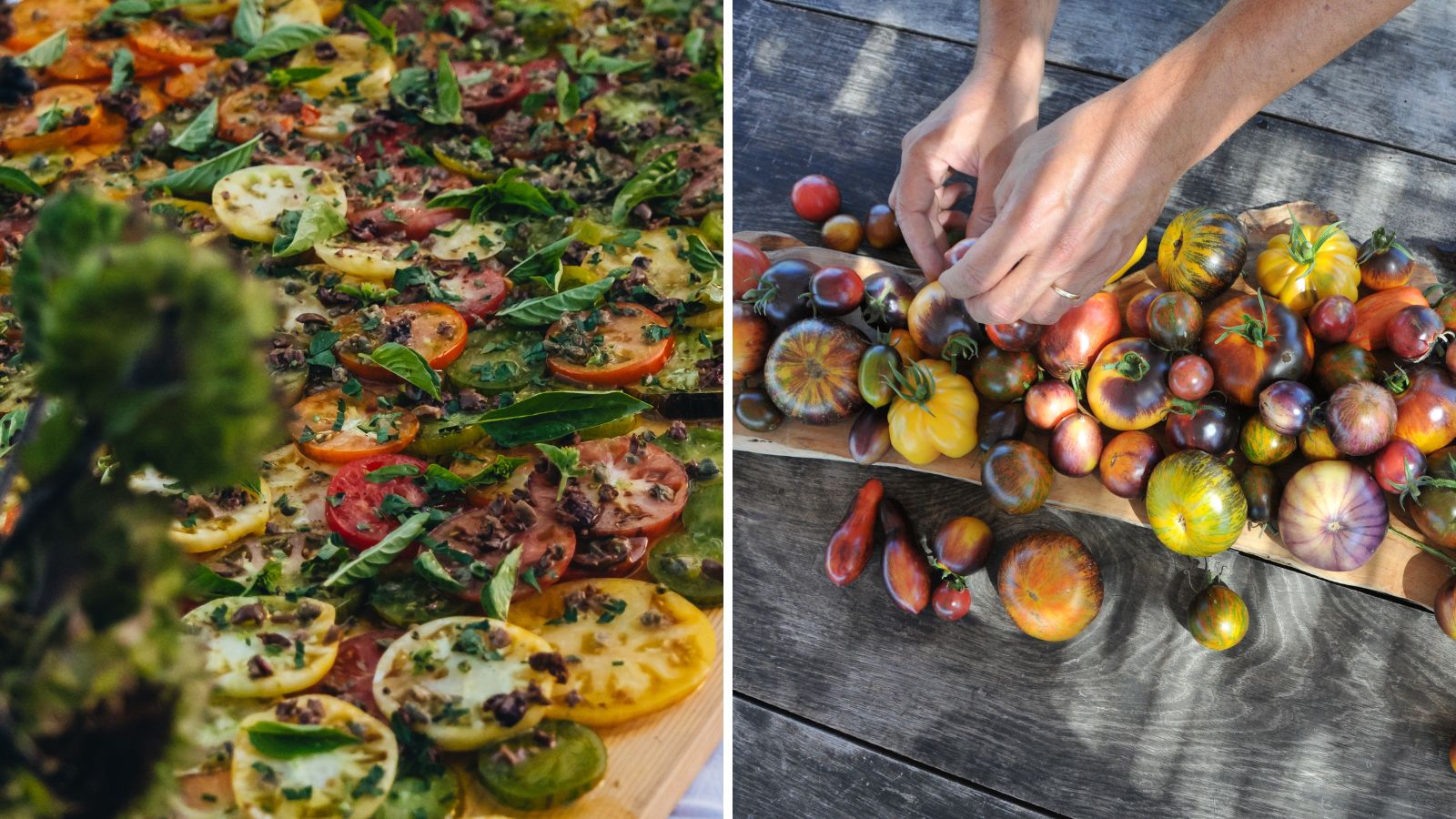
An extreme drought that triggered a Eureka moment
In 2022, Umbria – like much of Europe – experienced its worst drought in recorded history. From February to November, there was virtually no rainfall. The land cracked open. Crops withered. By summer, three brutal heatwaves sent temperatures soaring to 42°C. “We harvested peppers and tomatoes already ‘cooked’ on the plants. We had to make hard decisions to survive. We stopped producing preserves and focused only on supplying the farm shop. Letting crops die, due to lack of water, was devastating.”
"Farmers have always been told to ‘outsmart’ nature. But what if we turn that around?"
But then came a pivotal moment that turned this tragedy into the brother’s biggest inspiration. “One evening, my brother and I were walking through a patch of woodland, that leads from the farm to our parent’s house. As we stepped into the forest, we noticed something immediately: it was at least five or six degrees cooler than the open fields. Then we brushed aside some of the fallen leaves and discovered that the ground beneath was still moist. Life was thriving. Weeds weren’t taking over. Pests and pathogens were present but didn’t dominate."
"That’s when it hit us: no one irrigates the forest. No one fertilizes it. There’s no rotation scheme inside a forest. And yet it flourishes. Even in these harsh conditions. We’ve always been told that farmers have to ‘outsmart’ nature. But what if it’s the other way around? What if, instead of forcing nature to bend to our needs, we learn from her systems and adapt our farming accordingly?”
From single solutions to a systems approach
“Conventional farming is based on isolated fixes. Have a problem? Fix it, usually by killing it. A weed, a parasite, a pathogen – eliminate it. That’s how farming works. Organic farming is no different, other than some products are not allowed. But this reactive model only leads to dependency: each year, you need more inputs to get the same results.”
The epiphany in the woods made the two farmers realize they had to stop thinking in terms of problems and start thinking in terms of systems. “For instance, in natural ecosystems, the soil is never bare. When it is, weeds move in to cover it. So if you till the soil on your farmland, leaving it bare, nature will answer by growing infestant weeds. If you stop that practice and just occasionally cut the grass, the weeds will disappear. That's one of the many beautiful discoveries we had last year. You have to learn to work with the system, not against it.”
"We plan to stop crop rotation next year. That will cost us our organic certification"
The woodland showed them the way. Trees proved to be essential. They create shade, moderating temperatures. Even in winter, tree trunks can reduce the surrounding temperature by up to 5°C within a 10-meter radius. Fallen leaves become mulch, protecting the soil and feeding it with organic matter. And then there’s the soil itself. Healthy forest soil is teeming with life. “A single spoonful contains more microorganisms than there are humans on the planet. When you dig into that soil, you find bits of wood, even charcoal – remnants of ancient forest fires. These act like sponges, helping the soil retain moisture. Everything – absolutely everything – starts with healthy soil.”
Interesting detail: their hard-won organic certification probably won’t last for much longer. The siblings plan to stop crop rotation next year – something that is common practice in regenerative farming practices. Based on their experience they expect higher yields and improved workflow, leading to significant cost savings. That decision will probably cost them their organic certification, but as they have grown skeptical over the intrinsic value of it altogether, they don’t really seem to care.
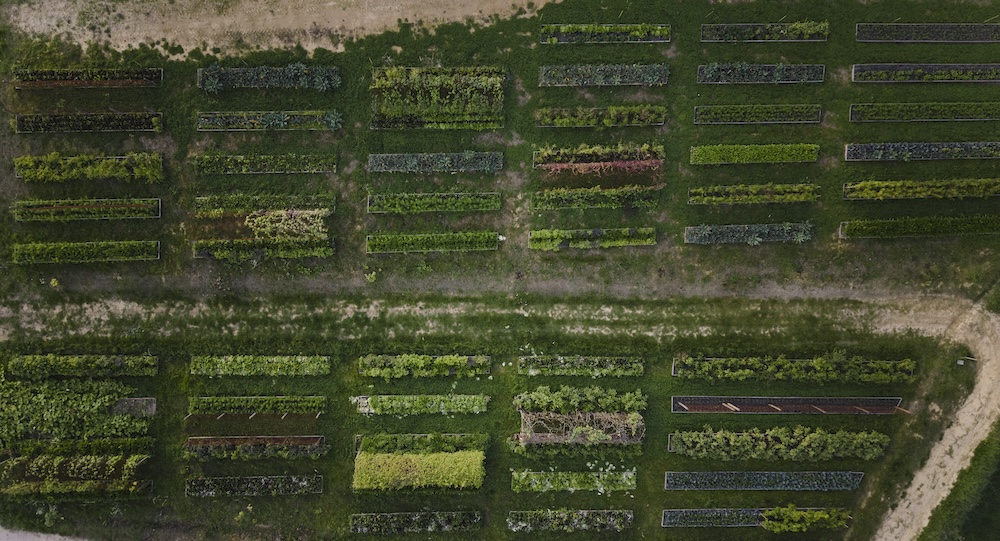
Applying nature’s lessons to farming
“Once we understood what nature was showing us, we asked ourselves: What solutions can we apply as farmers?” Quintosapore operates from five key techniques that form the backbone of the biomimic farming model:
1. Agroforestry – Paulownia Tomentosa
The first step was obvious: planting trees. “We began exploring agroforestry, the practice of integrating trees into agricultural systems. Typically, farmers choose productive species like fruit trees, nuts, olives, or figs – but these take decades to grow large enough to offer real shade. Many require irrigation and have root systems that compete with vegetables for nutrients.”
"We have planted 1,000 of the fastest-growing green trees in the world. These will start to create shade within two years"
“Then we discovered Paulownia Tomentosa – the fastest-growing green tree in the world. Under ideal conditions, it can grow up to 7 meters in a single year. That means we can create shade in just two to three years. What is mostly seen as an ornamental species is now becoming a cornerstone of our agroecological system. We’ve already planted around 1,000 Paulownia trees on our farm.”
Paulownia offers more advantages:
-
The trees flower in early spring, attracting a variety of pollinators and birds.
-
The leaves and flowers are edible. Its leaves have high natural concentrations of nitrogen, potassium, and magnesium.
-
Its root system doesn’t compete with other crops and the trees require no irrigation.
-
In summer, their canopy filters about 55% of sunlight – enough to cool, but not fully block sunlight – and in winter, the leaves fall, letting sunlight through.
2. Biochar – Mimicking the soil structure of forests
Biochar is a form of charcoal made by pyrolyzing various forms of plant biomass – like pruning residues, corn stalks, rice husks, dry foliage and almond shells. The result: a highly porous material made of 90% carbon. Biochar mimics the sponge-like quality of forest soil. It lightens the soil, enhances structure, and provides a habitat for microorganisms – creating a thriving underground ecosystem.
When applied to soil biochar:
-
dramatically improves water and nutrient retention.
-
enhances microbial activity and accelerates humus formation.
-
acts as a long-term carbon sink, aiding climate mitigation.
“As our Paulownia trees grow, we generate abundant biomass, that we can convert into biochar. So far, we’ve applied 1.5 tons – an enormous volume given how light it is. Within one year, water retention in our soil improved by 60%, and microbial life exploded.”
3. Effective Microorganisms (EM)
EM® – short for Effective Microorganisms – is a microbial cocktail developed by Japanese scientist Dr. Teruo Higa. It consists of 80 beneficial microorganisms – including nitrogen-fixing bacteria, yeast, mycelium, and aerobic and anaerobic bacteria – that work synergistically to improve soil fertility, suppress pathogens, increase nutrient uptake and boost plant resilience.
“At our farm, we use a machine that injects a 2% EM solution into water, applying it once a week. When we combined EMs with biochar, something remarkable happened: microorganisms reproduced twice as fast in the areas with biochar. It was an instant microbial love story. Over time, as the microorganisms settle in the soil, we can reduce the frequency and dosage, as the soil becomes self-sustaining.
"Within one year we measured jaw-dropping increases in nutrient levels in various crops"
“We were thrilled by the results. Plant productivity doubled, meaning that the amount of weight of harvest per plant doubled. It even created some unanticipated problems in the first year, where the vegetative explosion was so strong that we had to pull out some of the plants. Now we are planting tomatoes at 35 instead of 15 centimeters apart.”
And that’s not all. In partnership with the University of Urbino – home to Italy’s largest microbiology lab – the brothers started measuring nutrient density. Within one year we measured jaw-dropping increases in nutrient levels in various crops, like the polyphenolic acids in olive oil, vitamin C in tomatoes and fibers in curly kale. “Just like in our gut, microbial diversity in soil leads to healthier, more robust systems – for plants and people alike.”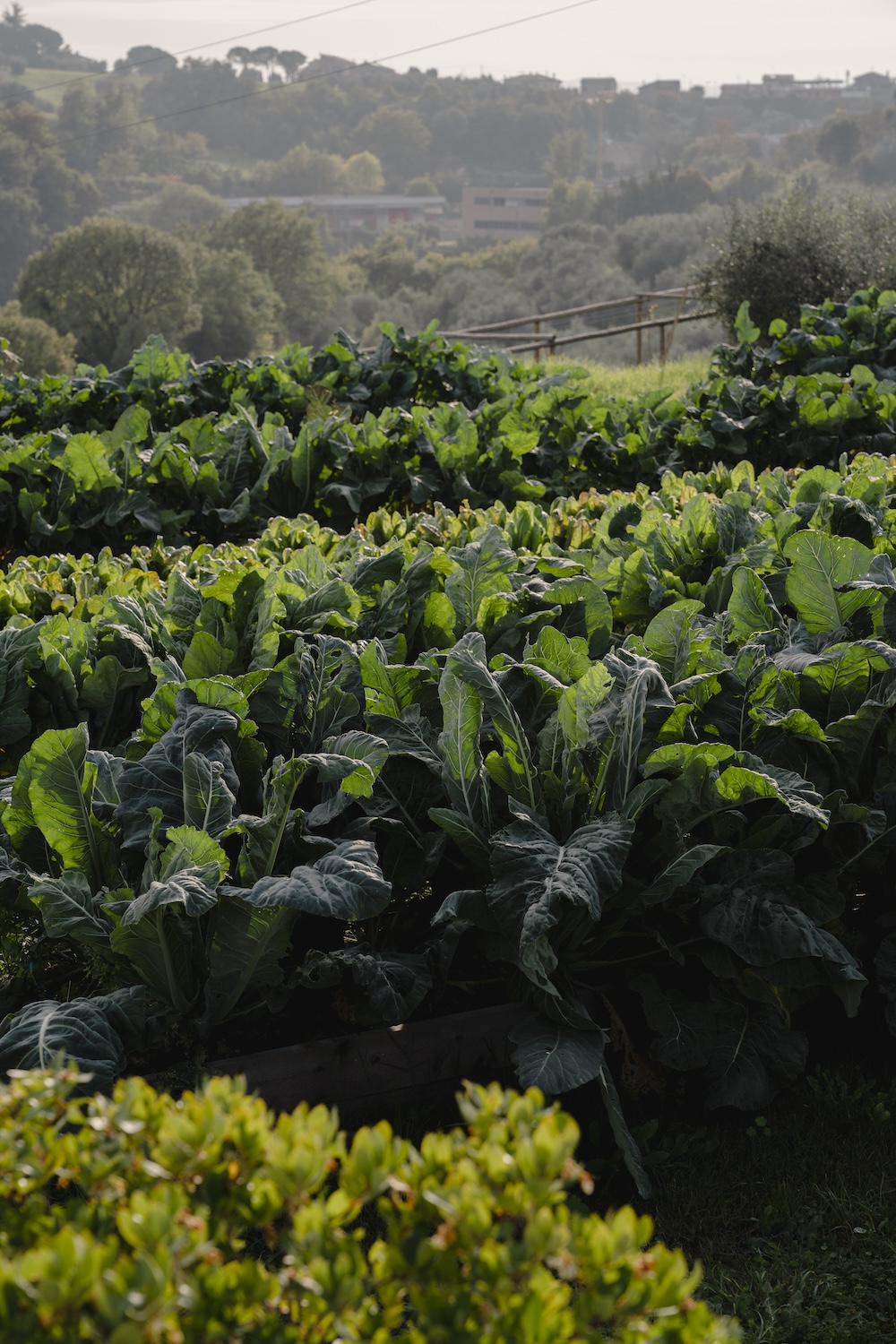
4. Quantum-Based Agriculture – Farming with frequency
Quantum-Based Agriculture is an emerging discipline that applies quantum physics concepts to agriculture. By understanding the interconnectedness of all elements, this approach seeks to optimize plant growth and soil health. It treats plants as energetic beings. Quantum-based agriculture aims to harmonize with nature’s energy fields, promoting healthier crops and ecosystems through a holistic view of farming. The goal? To increase yield, quality, and ecosystem balance.
Some effects of our newly adopted biomimic practices, we couldn’t explain at first. “We noticed that in the test beds where we applied the Effective Microorganisms, plants experienced fewer pest attacks. Even when insects landed on them, they didn’t eat the leaves. We knew the plants were stronger, but why? We reached out to botanists and agronomists, but no one had a clear answer.”
"Healthy plants vibrate at a higher frequency. Pests leave the strong plants alone, it’s a mechanism of natural selection"
“So we started collaborating with Italy’s National Research Council (CNR). They attached sensors to our plants and discovered something extraordinary: healthy plants vibrate at a higher frequency than weaker ones. Pests – nature’s cleanup crew – seem to detect and target plants with lower vibrational frequency. It’s a mechanism of natural selection: the strong are left alone. This discovery led us to explore the frontier of quantum-based agriculture.”
5. Anaerobic composting – Bokashi method
Bokashi composting is a process of fermenting organic waste using a specific mix of beneficial microorganisms. These microorganisms are usually a combination of bacteria, yeasts, and fungi.
“Unlike traditional composting, which relies on aerobic decomposition through oxygen, bokashi composting is anaerobic. The beneficial microorganisms in the bran start to ferment the organic matter, breaking it down completely. This method eliminates virtually all greenhouse gases related to organic waste cycling. Additionally, virtually all of the carbon returns to the soil, where it is safely sequestered.”
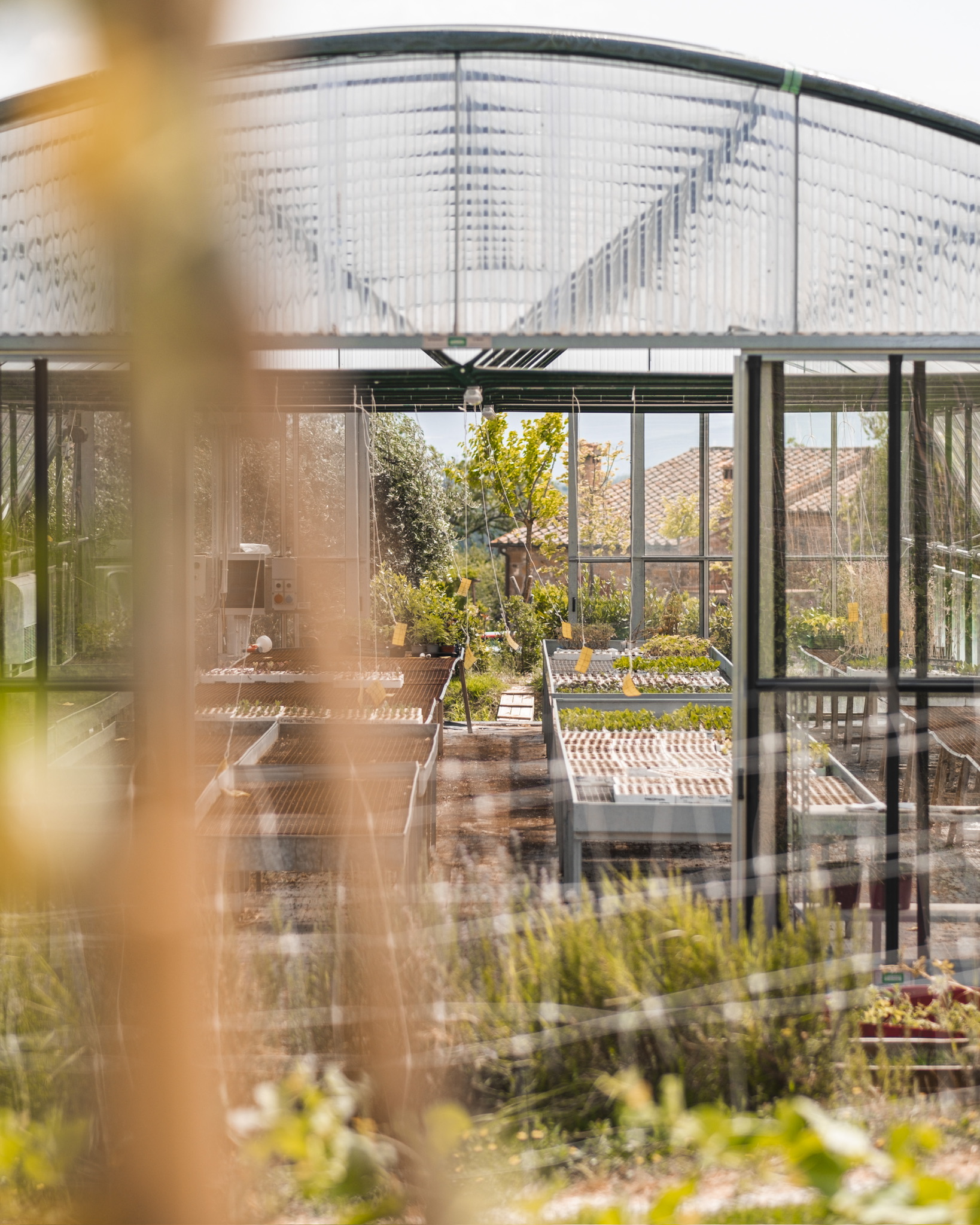
What comes next?
“We currently partner with various universities and research centers who are willing to share their knowledge and expertise, and are keen to learn from our methods and experiments. The plan for the next two years is to collectively build a scientific evidence base for biomimic farming, analyzing and validating all the collected data, so that we can share our findings publicly. Its the next step in our aspiration to become a blueprint for farms everywhere in the world.”
About Quintosapore
Location & Origins
-
Quintosapore is a regenerative, biodiversity-driven farm of around 25 hectares.
-
Located in the hills near Città della Pieve, right on the border between Tuscany and Umbria.
-
Founded in 2020 by twin brothers Alessandro and Nicola Giuggioli.
-
It’s the first farm in the world to implement biomimicry as a core working method.
-
With over 1,000 different species under cultivation, it’s considered one of the most biodiverse farms in the world.
-
They run a physical farm shop in the village that opens from Tuesday to Saturday.
Fun facts
-
The farm was born unexpectedly during the COVID lockdown. The brothers both happened to be visiting their parents when Italy shut down – so they decided to turn their childhood dream into reality.
-
Quintosapore gained international attention after being featured on CNN in the TV-series Stanley Tucci: Searching for Italy (2022).
-
After the episode aired in the U.S., requests poured in for the “Stanley Tucci Experience.” At the time, the farm had no guest infrastructure – early events were hosted with two folding beer tables and portable benches.
-
Although Umbria is known for olives, wine, and pork, it has no tradition of vegetable farming –until recently. When the farm launched, locals embraced their fresh produce immediately.
